
Visit Shrines
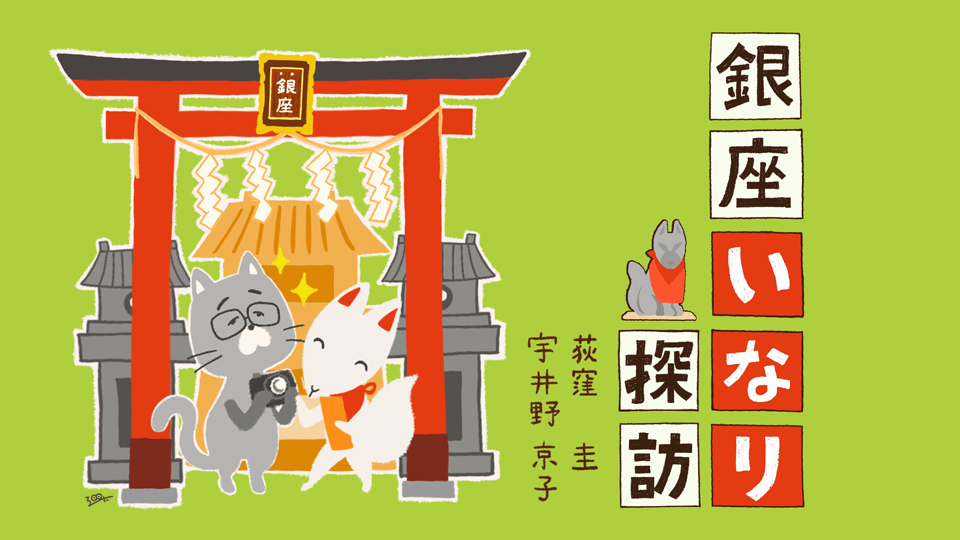
Visit Ginza’s Inari Shrines: Final Edition
2024.08.01
We hope you have enjoyed exploring the various deities guarding Ginza with us. This will be our final edition of the “Visit Ginza’s Inari Shrine” series.
- Uino
- Ogikubo san, we have visited many corners of Ginza together, but this will be our final episode. I certainly enjoyed our strolls and there was always much to learn. I am truly grateful to the various shrines and everyone who received us. I hope we were of some help to our readers.
- Ogikubo
- So, it is already our final edition. I would like to thank everyone who have joined us in our strolls. Personally, it was an enriching experience for me, accompanied by Uino san. When I explore a town, I usually look at old maps and try to discover small pieces of history remaining there. I had always been curious about how Inari Shrines could be found in the smallest corners even in a town like Ginza, where the land prices are so high and the buildings are built closely together with no space between them. In our series, we tried to create as many opportunities as possible to talk directly with the people who are taking care of the shrines and there was so much to learn.
- Uino
- We were able to reacknowledge that Ginza is supported by the involvement many different people. It is fascinating that so many shrines exist within walking distance across Ginza 1-chome to 8-chome.
- Ogikubo
- The Inari deity for business prosperity and fire protection is indispensable in a commercial town. Hence, we could feel a strong will and creative efforts to preserve the shrines for local businesses. Although each shrine is small, we would always encounter a visitor who presumably works in Ginza on our visits.
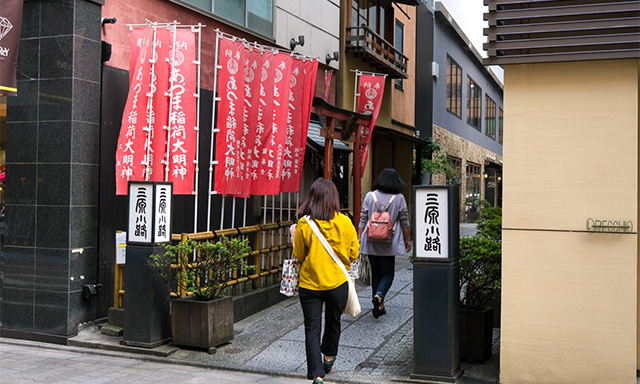
- Uino
- They are places for everyday wishes. Visiting the shrines are almost like a customary practice that has been passed down from ancestors.
- Ogikubo
- I was also very happy to be able to see those shrines which are usually closed to the public.
- Uino
- Not only in Japan, but throughout the world, I think it is rare to see so many places of prayer in such a small busy area. I wish more foreign visitors could be exposed to this aspect of Ginza, in addition to the shopping it offers. Ginza holds a stamp rally that takes visitors around the different deities scattered across Ginza. As I mentioned in the series, some of the shrines are open to the public only during the event.
- Ogikubo
- Since this is our last edition, I mapped out all the shrines we visited on one map. I thought it would be good to have a map to allow us to walk through Ginza to visit the shrines one by one. By the way, was there some kind of logic to the sequence of the shrines we introduced?

A number of shrines, Fudo Moyoo and Jizo Bosatsu were visited.
- Uino
- They were basically in the order of the Japanese alphabet.
- Ogikubo
- So that is why we went from one place to another.
- Uino
- Therefore, in our last edition, I would like to find the ideal walking route for visiting various shrines in a time-efficient manner.
- Ogikubo
- Then let us start in Ginza 1-chome and work our way to 8-chome. Ginza is located between Kyobashi and Shinbashi, so let us start in Kyobashi.
- Uino
- Our first stop is Saiwai Inari(https://www.ginza.jp/visit-shrines/18550). A building was constructed in the redevelopment of the area, but the shrine was saved in a corner of a narrow backstreet.
- Ogikubo
- It used to face Namiki-dori, didn’t it? Our next stop is very close by. Ginza Inari Shrine(https://www.ginza.jp/visit-shrines/17409) sits on the rooftop of Echigoya Building in Ginza 2-chome. It used to sit behind the building but was moved to the rooftop of Echigoya Building. Since it sits in very limited space, it is closed to the public.
- Uino
- The deity comes out to an Otabisho (temporary resting point) in the entrance of the building during the stamp rally event.
- Ogikubo
- Where shall we go next?
- Uino
- I would like to recommend Yasuhira Shrine.
- Ogikubo
- Then let us cross Ginza-dori, cross Showa-dori, and walk toward Tsukiji. Yasuhira Shrine sits in a corner of the premises of a high-story condominium.(https://www.ginza.jp/visit-shrines/28194)
- Uino
- The shrine was originally worshiped as the guardian god of Manyasuro, but today, it forms a beautiful part of the residence, with its original decorative stones kept in the landscape.
- Ogikubo
- Since we have come to former Kobikicho, let us stroll through Kobikicho. If we walk from Yasuhira Shrine in the southeast direction on Kobikicho-dori, we will arrive in front of Hoju Inari Shrine(https://www.ginza.jp/visit-shrines/24338). Hoju Inari Shrine is a spectacular shrine facing the main street. When I recently came by, the building next door had just been demolished and the land had be cleared, so I have a very good view of the main building of the shrine.
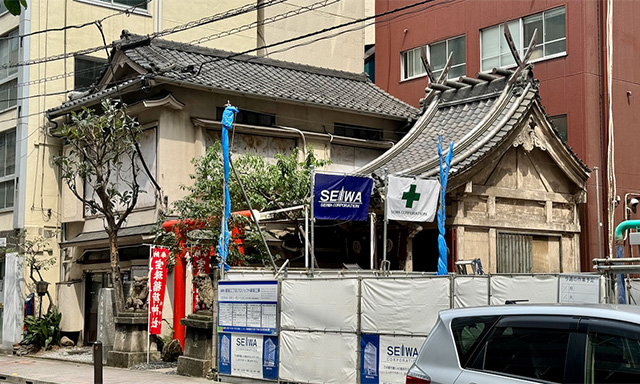
- Uino
- Hoju Inari is located in a very popular area. Kabuki Inari Shrine is very close by too. Visitors will have a chance to take a picture in front of the beautiful façade of Kabukiza Theater.
- Ogikubo
- It is sitting in a corner of Kabukiza Tower(https://www.ginza.jp/visit-shrines/17084). If you are a little tired, you can take a rest in Kobikicho Hiroba on the basement floor if you are a little tired. Where shall we go next?
- Uino
- Let us walk along Harumi-dori to Ginza Mitsukoshi. On the rooftop of the Main Building sit Shusse Jizoson and Mimeguri Shrine.(https://www.ginza.jp/visit-shrines/19524) I recall that you found the Shusse Jizo already marked on a map from 1911 (Meiji 44). I also found a passage on a festival for the Shusse Jizo along with a picture in a book published from Shirakawa Shoin called “Ginza no Shijo (Poetic sentiments of Ginza)”.
- Ogikubo
- So, it was already called Shusse Jizoson during the Meiji period. It is marked where the Annex Building of Ginza Mitsukoshi stands today, so it is understandable that it was moved to the rooftop of Ginza Mitsukoshi Main Building when the Annex was newly constructed.
- Uino
- A number of shrines are concentrated in this area. The Ryuko Fudoson(https://www.ginza.jp/visit-shrines/25078)on the rooftop of Matsuya Ginz and Asahi Inari(https://www.ginza.jp/visit-shrines/15283), and Hodo Inari Shrine(https://www.ginza.jp/visit-shrines/26279)in Ginza 4-chome are all located close by so they can be visited as you like, in between shopping and coffee.
- Ogikubo
- At Asahi Inari Shrine, you can visit the Main Shrine when the elevators are in operation. I would certainly recommend visitors to go up to the roof. You will have to go up a flight of stairs after getting off the elevator.
- Uino
- Now that we have arrived in the center of Ginza, lets wrap up the first half of our tour, the “Kyobashi Route”.
- Ogikubo
- Let us begin the latter half of our tour. Since we are starting at the Ginza 4-chome intersection and heading toward Shimbashi, let us call it the “Shimbashi Route.”
- Uino
- Let us go. Our first stop is Azuma Inari Shrine(https://www.ginza.jp/visit-shrines/16633). It is located on Azuma-dori, the street behind Ginza-dori.
- Ogikubo
- If you continue straight ahead, you can walk through GINZA SIX to the other side. You can feel the will of the local people to maintain the town layout from the fact that they left a passage that runs through GINZA SIX. On the rooftop of GINZA SIX, you can visit Kakugo Inari Shrine(https://www.ginza.jp/visit-shrines/16195)the guardian god of Matsuya Ginza. Let us take the elevator up to the rooftop. From Azuma Inari, the elevator on the southern side should be closest.
- Uino
- Once you are on the rooftop of GINZA SIX, you should take a stroll around to look out in all four directions.
- Ogikubo
- Our next stop is Kumagai Inari Shrine(https://www.ginza.jp/visit-shrines/17900)in Ginza 6-chome. This shrine sits on the other side of Sanjikken River, so it’s address would be in Kobikicho. It is easy to spot as its Torii Gate faces Hanatasubaki-dori.
- Uino
- From here, we should walk westward along Hanatsubaki-dori to Toyoiwa Inari Shrine(https://www.ginza.jp/visit-shrines/27210) located behind Shiseido Main Office. Please be careful not to miss it as it sits in the back of a very narrow street It actually has two entrances, so let’s see if you can find them.
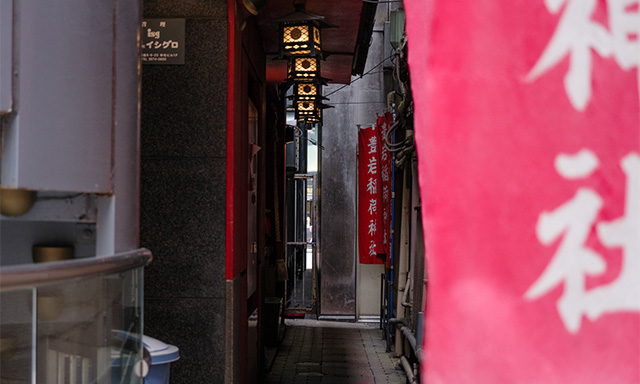
- Ogikubo
- I was surprised to learn that there were so many Inari Shrines across Ginza 7-chime and 8-chome. Komparu Inari Shrine(https://www.ginza.jp/visit-shrines/20369)at Shimbashi Kaikan and Mankin Ryujin Seiko Inari Shrine(https://www.ginza.jp/visit-shrines/21553)at Shiseido Main Office building are both located on the rooftop of the respective buildings and are thus closed to the public.
- Uino
- Mankin Ryujin Seiko Inari Shrine can be visited on the first floor of Shiseido Main Office building during the stamp rally event. Komparu Inari Shrine can also be visited at a Otabisho (temporary resting point) from August 1 during the Nohgaku Komparu Matsuri festival.
- Ogikubo
- Now our fina destination is Hachikan Shrine.(https://www.ginza.jp/visit-shrines/22548) Now that we look back, we have visited quite a number of shrines.
- Uino
- I am sure that anyone who goes around all of the shrines will become a fan of each deity. Of course some may find a favorite.
The next time we come to Ginza, we can drop by a shrine close to our destination. Ogikubo san, what impressed you most exploring Inari Shrines in Ginza? - Ogikubo
- Above all, I was impressed by how they have been so creative about the siting of the shrines. Ginza is Japan’s commercial center and has the most expensive land prices. The selection of the locations show how even in a high-end place like Ginza traditional deities can be preserved. Some shrines have been moved to the rooftop of a building, some are located in the back of a narrow street, and others are movable. Shrines established in commercial areas are originally for the local people and do not need to be facing the main street. That makes it all the more interesting.
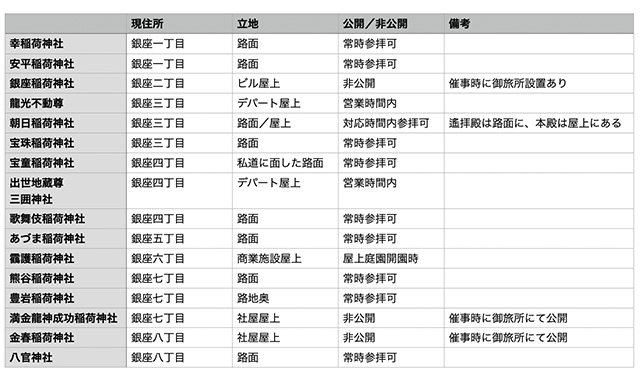
- Uino
- I tried to introduce as many shrines as possible but there are shrines yet to be visited in Ginza. Whether or not they are open to the public, as a guardian, I would like to continue to protect these places of prayer from the turbulence of a changing world.
By the way, strolling in Ginza during our visits, many other aspects caught our eyes. - Ogikubo
- Absolutely. My curiosity took me this way and that as we strolled the streets. I would sometimes to go out of my way to look at an old picturesque building that caught my eye.
- Uino
- How about exploring those buildings that you were so curious about in our next series?
- Ogikubo
- I would certainly be excited to join you. I had been thinking that one of Ginza’s charms is how buildings from before World War II stood side by side with new buildings built in the Reiwa period.
- Uino
- Then the title will be “Exploring Ginza’s Buildings”. I look forward to having our readers join us in our next adventure.
All List
- 2020.05.01 Visit Ginza’s Inari Shrines Vol.2 Asahi Inari Shrine
- 2020.08.01 Vol.3 Exploring Ginza in the Edo Period on an old map
- 2020.11.01 Visit Ginza’s Inari Shrines Vol. 4 Kakugo Inari Shrine
- 2021.02.01 Visit Ginza’s Inari Shrines Vol. 5 Azuma Inari
- 2021.05.01 Visit Ginza’s Inari Shrines Vol.6 Kabuki Inari
- 2021.08.01 Visit Ginza’s Inari Shrines Vol.7 Ginza Inari in Ginza 2-chome
- 2021.11.01 Visiting Ginza’s Shrines Vol. 8 Kumagai Inari Shrine
- 2022.02.01 Visit Ginza Shrines Vol. 9 Saiwai Inari Shrine
- 2022.05.01 Visit Ginza’s Shrine Vol. 10 Mimeguri Shrine and Shusse Jizoson on the roof of Mitsukoshi Department Store
- 2022.08.01 Visit Ginza’s Shrines Vol. 11 Komparu Inari
- 2022.11.01 Visit Ginza’s Inari Shrines Vol.12 Mankin Ryujin Seiko Inari Shrine
- 2023.02.01 Visit Ginza’s Shrines Vol.13 Hachikan Shrine
- 2023.05.01 Visit Ginza’s Inari Shrines Vol.14 Hoju Inari Shrine
- 2023.08.01 Visit Ginza’ Inari Shrines Vol. 15 Ryuko Fudo-son
- 2023.11.01 Visit Ginza’s Shrines Vol. 16 Hodo Inari Shrine
- 2024.02.01 Visit Ginza’s Shrines Vol. 17 Toyoiwa Inari Shrine
- 2024.05.01 Visit Ginza’s Inari Shrines Vol. 18 Yasuhira Shrine
- 2024.08.01 Visit Ginza’s Inari Shrines: Final Edition








